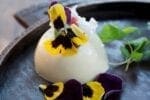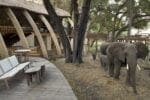When is the best time to visit the Okavango Delta in Botswana? It is a year-round wildlife destination, however; certain seasons are more suitable for special interests than others.
Best time to visit Okavango Delta
The following information is to be treated as a guideline as weather patterns and wildlife rhythms are never predictable and can never be guaranteed at a specific time or in a specific area.
January
In January, bird viewing is excellent; therefore; it is an excellent time to visit the Okavango Delta. It is the peak breeding time for many of the colorful migrant bird species. Excellent wildflowers, brilliant green foliage, and constant sounds day and night – from insects and birds. The bush is alive. January is in the middle of the rainy season. Spectacular afternoon thunderstorms, high humidity, and warm days (average 30°C plus) and nights (20°C plus). Game viewing is reasonable with active predators still chasing the fast-developing young of their prey species.
January is an ideal time to visit the Okavango Delta for photography; due to all the vivid colors, spectacular skies, and unparalleled air clarity. The contrast of the predators’ natural winter camouflage with the summer colors makes for dramatic photos.
February
Ripe figs are eaten by many species; including the fruit bats that make interesting night sounds while feeding. It is the peak flowering time for water lilies. The reed frogs are colorful and noisy. The Okavango Delta is brilliant, noisy, and alive in February. Butterflies, birds, frogs, and all the small creatures are full of life and at their best. The rains continue in the form of mid to late afternoon thunderstorms with dramatic skies and sounds. It is hot with daytime temperatures averaging above 30°C and warm nights at 20°C plus. There may be both wet and very dry spells within the month. The giant bullfrog emerges from months and sometimes years of hibernation to indulge in nocturnal feeding frenzies. The resident game species do not have far to go for water and the young are almost as tall as the adults. Birding is excellent.
March
The fruit of the Marula trees attracts their attendant bull elephants that wander from tree to tree in search of their favorite meal. At this time of year; elephants are often encountered on walks in the Okavango as they feed on the Marula trees. The start of the rutting season leads to the sleek and fat impala males snorting and cavorting to attract females. Temperatures are still warm both day and night but the air is drier and the rains less frequent. The bush is lush and green and there are lots of flowers.
April
The first signs that the times are changing; night temperatures drop to below 20°C on average; but day temperatures continue to rise to 40°C on some days. Generally, the temperatures are very pleasant in April in the Okavango Delta. The cooler mornings with high relative humidity lead to wonderful early morning misty magic; especially over water. The impala rut is in full swing and the impala noises continue right through the night with dramatic clashes between rival males. Baboon and impala are often seen together as the baboon act as sentries protecting the busy impala. The trees have completed flowering and fruit is ripening, with massive sausages hanging from the Sausage trees. Reptiles are actively breeding and feeding in anticipation of the dry season, which is about to start.
May
Floodwaters from the Angolan highlands should reach the top of the Okavango Delta panhandle and begin their slow and deliberate progress through the Delta. The rains are over and the nights are cooler with temperatures averaging 15°C. The days are still warm with temperatures up to 35°C. Buffalo’s begin to group into large herds and visit the river areas more often as the seasonal pans begin to dry. Breeding herds of elephants increase in density daily as they visit the permanent waters of the Okavango Delta. The vivid green bush starts fading to duller dry season colors and the predators begin to enjoy themselves as their colors blend in with their surroundings once again. The migratory birds begin their flights to winter feeding and breeding grounds in faraway places.
June
June is an exciting month to visit the Okavango Delta. The African wild dogs begin to search for dens, which makes them easy to find for the next three or four months as they operate from their dens. Exciting hunts and playful puppies – what more could you wish for! Temperatures have dropped to their coldest by the end of June with night temperatures reaching as low as 5°C (very cold on night drives due to wind chill factor). Daytime temperatures rise to a very comfortable 25°C and dusty dry conditions begin to dominate. Some green bushes and trees persist but leaf drop commences and pans dry up. Animals congregate at permanent water sources, as do their predators. The inner Delta starts to flood.
July
It is the height of the floods for the Okavango Delta, after a slow path from the wet Angolan highlands thousands of kilometers away. The paradox is obvious – the flood arrives when dust and dryness pervade and the rains have long gone. The leaves are falling off the trees, grasses are getting shorter every day and visibility is excellent. The nights are still cold but the days are marginally warmer and the weather typical of Botswana – sunny and clear with brilliant cobalt blue skies.
More and more animals congregate near the water and flood plains – July is a special time of the year in the Okavango Delta. Water seeps into areas where there was none the day before and the Mekoro and boat trips become more exciting as new channels and waterways can be accessed. Soft early morning and evening light combined with dust provides the opportunity for many dramatic photo settings.
August
The elephant herds are getting larger. As they jostle for space near the water, tension rises between the breeding herds. The bush is bare and the dust pervades but there is plenty of action and with patience and perseverance the rewards are great in August. The floods have passed through the Okavango Delta and now reach Maun. The weather is warming up with daytime peaks averaging closer to 30°C. Night time averages rise to around 10°C. August is another special month in the Okavango Delta; as well as being peak visitor season. The herons, storks, and other birds start to congregate at the Gadikwe heronry.
September
The climate has changed and winter is all but gone. Night temperatures rise rapidly within the month and by month-end, the average reaches 15°C plus. Day temperatures soar well into the ’30s (Celsius). The sun shines, the skies are clear and it is really dry. Unbelievably the elephants concentrate in still greater numbers. As do the buffalo; keeping the predators busy as the season takes its toll on the prey species. It is a time of plenty for the lions. The colors explode as the carmine bee-eaters return for the summer. The first migrants arrive and storks start nesting. Water levels have slowly started to drop as the waters from Angola have completed their trek. Certain trees start to produce their first green shoots – fed by the floodwaters and temperatures and not by any rain, as the first rains are still about six weeks away.
October
It is hot – really hot but never will you experience such great game viewing – well worth the sweat. This is the time of year when the herbivores are at their weakest because of a lack of food and the lions are at their strongest. Day temperatures rise regularly above 40°C and nights are warm with averages in the 20°C. There is no place to hide, everything is bare and the grasses have been eaten or trampled. Predator chases erupt into clouds of dust as the eternal game of ‘eat and be eaten’ plays out daily in the very open plains. Fishing frenzies with the annual catfish (barbell) runs in the rivers. The Gadikwe heronry is full of activity with hundreds of birds breeding and nesting therefore bird viewing is excellent in October in the Okavango Delta.
November
The expectation, in fact, desperation for rain dominates all discussions. The residents and the animals all seek an end to the dryness and dust. Temperatures remain high both day and night and game viewing is excellent; until the day of the first rains; normally around mid-November. The rains come, the animals relieved; disperse to eat on new vegetation, and drink from the seasonal pans. The birthing season begins with the tsessebe, followed by impala and Lechwe. The predators seek out the vulnerable young and kill many times a day to get their fill. It is a time of action; great visibility and color with big clusters of clouds, fresh sprouting grass, and trees bursting into life. November is a wonderful time to visit the Okavango Delta for the keen photographer.
December
Protein-rich grass feeds the mothers of the antelope while the lambs and calves grow at astounding speed. The impala complete their lambing; the wildebeest start and complete in just a few weeks. The rains become more regular with thunderstorms every few days. The pans remain full and the colors shine in brilliant green. While the grazers enjoy the green tender mouthfuls; the predators are ever watching and stalking. Their winter camouflage lets them down so they have to work harder. However, the bush is dense allowing more hiding places for them to observe their prey. All the migrant birds have arrived and the birding is excellent. Temperatures have cooled on average but hot days still occur and nights are still warm. Humidity can rise after rain. Great colors, dramatic skies, and lightning at night all add to the magic of visiting the Okavango Delta in December.
When is the best time to visit the Okavango Delta for a birding safari?
The summer season in Botswana welcomes a large variety of migrant birds from the northern hemisphere. They use Botswana; and more specifically the Okavango Delta; as preferred areas for breeding and feeding.
The first migrants arrive from the Northern Hemisphere during September. By December all the migrants will have arrived which means there are 20% more birds in Botswana during the summer months compared to the winter months. The period from December to March is very active and the colors, more specifically the birds in breeding plumage, are spectacular.
The Okavango Delta is a birders paradise that entertains both the experienced ornithologist as well as the eager amateur. More information can be found about birding in Botswana on our Botswana birding safaris page.
So, when is the best time to visit the Okavango Delta? All year round has something special to offer its visitors.
























































